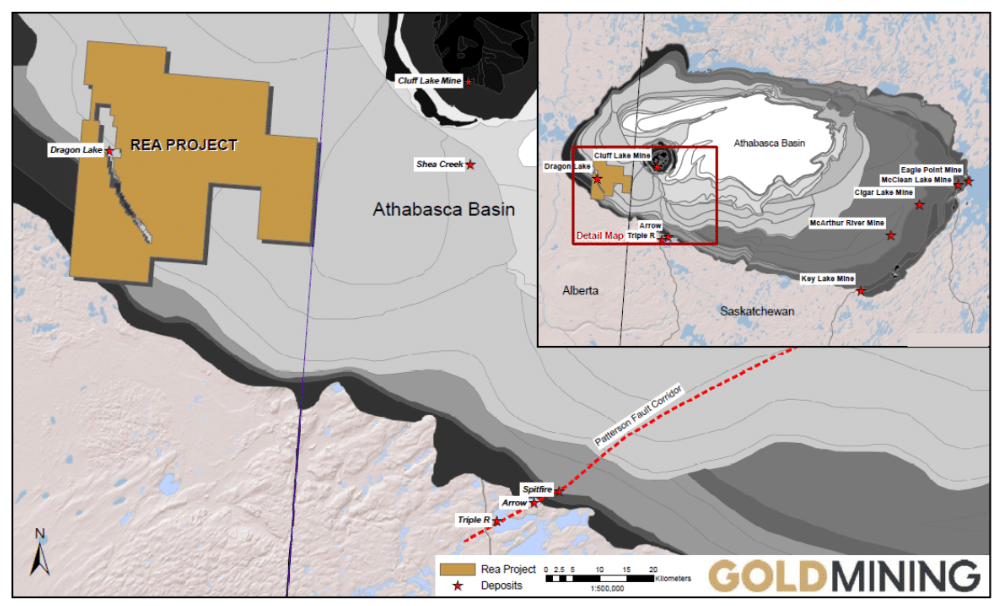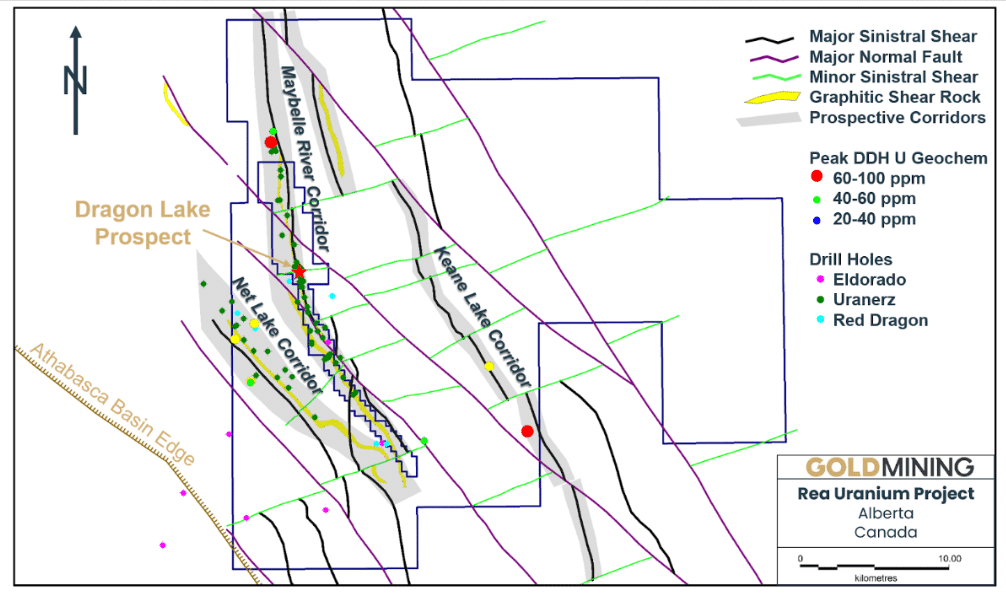Disclaimer: Disseminated for GoldMining Inc.
From the latest press release, we discovered that GoldMining Inc. (GLDG: NYSE) has unveiled promising preliminary results from reprocessing, inversion, and modeling of historic geophysical surveys on its Rea uranium project in the Western Athabasca Basin, Alberta, Canada. The Rea Project, with GoldMining holding a 75% stake and Orano Canada holding the remaining 25%, spans approximately 125,328 hectares around Orano’s high-grade Dragon Lake prospect.
Furthermore, located 60 km southeast of the Rea Project are world-class uranium deposits, including Fission Uranium Corp.’s Triple R deposit and NexGen Energy Inc.’s Arrow deposit. Both these projects are currently in development phase.
Navigating the Athabasca Basin’s Strategic Frontiers
GoldMining’s CEO Alastair Still has expressed his excitement about the Rea project in the following statement:
“We are extremely encouraged by the targets we have generated within the Athabasca Basin, an area that contains some of the world’s largest and highest-grade uranium deposits. This work enhances our activities that have and continue to focus on unlocking value within our portfolio of gold and gold-copper projects located throughout the Americas.”
He further emphasized the impressive, cost-effective work by GoldMining’s technical team, underscoring their strategic approach to significantly enhance shareholder value.
The team also utilized modern reprocessing techniques and inversion modeling of historic geophysical surveys to identify over 70 km of prospective areas for follow-up exploration. These areas, spanning three distinct corridors, exhibit geophysical signatures similar to known Athabasca Basin uranium deposits.
Rea Project: Unlocking Promising Uranium Potential
1. Strategic Location
The Rea Project comprises 16 contiguous exploration permits covering about 125,328 hectares around Orano’s Maybelle River project, featuring the shallow Dragon Lake prospect. Located roughly 175 km north-northwest of Fort McMurray, Alberta, the project is accessible via winter roads and air charter.

2. Geophysical Insights
Reprocessing, inversion modeling, and reinterpretation of historic surveys have mapped over 70 linear kilometers of basement conductive trends. They are interpreted as graphite-bearing shear zones, indicative of potential unconformity-style uranium mineralization.
3. Three Prospective Corridors
Maybelle River Corridor (11 km): Extending northward from Orano’s Maybelle River Project, where shallow, high-grade uranium mineralization is hosted at the Dragon Lake prospect. Dragon Lake, discovered in 1988, has previously reported historic high-grade drill intersections including 17.7% U3O8 over 5 m in MR-39 and 4.7% U3O8 over 1.7 m in MR-34.
-
- Five historic drill holes on the Company’s Rea Project claims tested a portion of the Maybelle River Corridor, intersecting anomalous uranium values in two holes and anomalous pathfinder elements and minerals—including clay alteration and dravite, a distinctive accessory mineral linked to many significant Athabasca uranium occurrences—in three holes.
Net Lake Corridor (20 km): 20 widely spaced drill holes have tested the area, with five intersecting anomalous uranium and associated pathfinder elements such as vanadium, nickel, cobalt, and arsenic, as well as pathfinder minerals like clay alteration and dravite
Keane Lake Corridor (40 km): The area remains largely unexplored, except for two historic drill holes that intersected anomalous uranium values in the south-central area of the Project.
Significant Geological Findings and Future Exploration
Each of the three prospective corridors is interpreted as a potentially significant and deeply rooted basement structure, fundamental to the formation of Athabasca uranium deposits. Drill-proven fault and shear zones have been intersected on both the Maybelle River and Net Lake corridors. Follow-up exploration programs will include additional geophysical surveys to refine targets before drilling.
Exploration Focus: Uranium Deposits in the Athabasca Basin
Geological Context and Deposit Characteristics
In the Athabasca Basin, conductive graphite-bearing shear zones in basement rocks beneath sedimentary layers are intricately associated with unconformity-related uranium deposits. These shear zones, identifiable through electrical geophysical methods, typically underlie extensive hydrothermally altered zones within the overlying sandstone.
Uranium mineralization often occurs near the unconformity within sandstone. Notable deposits, such as Fission’s Triple R and NexGen’s Arrow, specifically occur within graphitic shear zones in the basement rocks.
Geophysical Survey and Interpretation
GoldMining Inc. recently enlisted Fathom Geophysics LLC to process, invert, and model historical airborne and ground geophysical surveys within the Rea Project area. These surveys, conducted between 2005 and 2009, include Versatile Time Domain Electromagnetics (EM), magnetic surveys, Induced Polarization (IP) surveys, and Full Tensor Gradiometry data. These surveys’ resulting structural and lithological interpretation aligns closely with the modeled geophysical data and the regional tectonic framework.

GoldMining Inc. is a public mineral exploration company focused on gold assets in the Americas. It controls a diversified portfolio of resource-stage gold and gold-copper projects across Canada, the U.S., Brazil, Colombia, and Peru.
The company also holds significant shares in Gold Royalty Corp., U.S. GoldMining Inc., and NevGold Corp. Moving forward, the company remains committed to further exploration and development to unlock substantial value within its diversified portfolio of mineral assets across the Americas.

